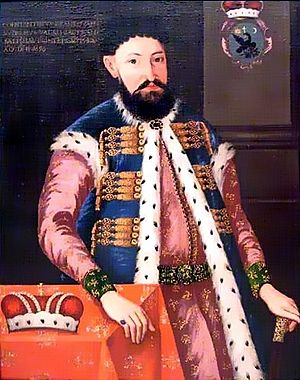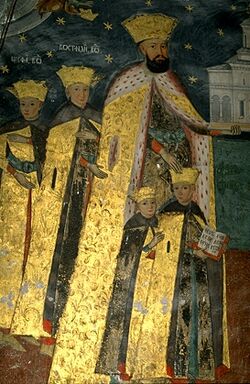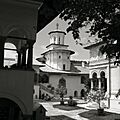Constantin Brâncoveanu facts for kids
Quick facts for kids Constantin Brâncoveanu |
|
|---|---|
 |
|
| Prince of Wallachia | |
| Reign | October 1688 – 15 August 1714 |
| Predecessor | Șerban Cantacuzino |
| Successor | Ștefan Cantacuzino |
| Born | 15 August 1654 Brâncoveni, Wallachia |
| Died | 15 August 1714 Constantinople, Ottoman Empire |
| Spouse | Doamna Marica Brâncoveanu |
| Issue | Stanca (1676) Maria (1678) Ilinca (1682) Constantin (1683) Ștefan (1685) Safta (1686) Radu (1690) Ancuța (1691) Bălaşa (1693) Smaranda (1696) Matei (1698) |
| Religion | Eastern Orthodox Christian |
| Signature |  |
| Saints Constantin, Constantin, Ștefan, Radu and Matei Brâncoveanu | |
|---|---|
 |
|
| Born | 1654 (Constantin) 1683 (Constantin) 1685 (Ștefan) 1690 (Radu) 1698 (Matei) Brâncoveni, Wallachia |
| Died | 15 August 1714 Istanbul, Ottoman Empire |
| Venerated in | Romanian Orthodox Church and Russian Orthodox Church |
| Canonized | 20 June 1992, Bucharest |
| Major shrine | Relics at the New St. George Church, Bucharest. |
| Feast | 16 August (Eastern Orthodox Church) |
| Attributes | They are usually depicted together, wearing golden cloaks. |
Constantin Brâncoveanu (born 1654 – died August 15, 1714) was a very important Prince of Wallachia. He ruled for a long time, from 1688 to 1714.
Contents
Who Was Constantin Brâncoveanu?
Early Life and Rise to Power
Constantin Brâncoveanu came from a powerful noble family called the Craiovești boyars. He was born on his family's estate in Brâncoveni. He grew up in the home of his uncle, Constantin Cantacuzino.
He became prince after his uncle, Prince Șerban Cantacuzino, passed away. At first, his maternal uncles, Constantin and Mihai Cantacuzino, supported him. But as he ruled, he became more independent. This made his uncle Constantin Cantacuzino unhappy, and he started to support his own son, Ștefan Cantacuzino, for the throne.
How He Ruled Wallachia
Prince Brâncoveanu tried to make alliances against the Ottoman Empire. He talked with the Habsburg monarchy (a powerful European family) and then with Peter the Great of Russia. This was during the Russo-Turkish War, 1710-1711.
When Russia got involved in Moldavia in 1710, Brâncoveanu contacted Tsar Peter. He even accepted gifts from the Tsar. However, he had a rivalry with the Moldavian Prince Dimitrie Cantemir, who was Russia's main ally in the region. This made it hard for Brâncoveanu to fully commit to Russia.
He gathered his troops near the Moldavian border. He was ready to help the Tsar if Russian troops entered Wallachia. But he was also ready to join the Ottomans if things changed. When some of his nobles fled to the Russian side, he had to choose. He quickly returned the gifts from Russia and sided with the Ottomans. He didn't want to become an enemy of his Ottoman overlords.
His Arrest and Execution
Eventually, the Ottoman government found out about Brâncoveanu's secret dealings. In 1714, Sultan Ahmed III removed him from power. Brâncoveanu was arrested and taken to Istanbul. He was imprisoned in the Yedikule (also known as 'the Seven Towers').
The Ottomans tortured him, hoping to find his large fortune. On August 15, 1714, he and his four sons were beheaded. His loyal friend, the grand treasurer Enache Văcărescu, was also executed. Most importantly, they were all asked to give up their Christian faith and become Muslim. They refused, choosing to stay Christian.
According to his secretary, Anton Maria Del Chiaro, their heads were shown on poles in Istanbul. This caused a lot of anger among the people. Fearing a rebellion, the Sultan ordered their bodies to be thrown into the Bosporus strait. But Christian fishermen found the bodies and buried them at the Halchi Monastery nearby.
A Saint for His Faith
Death and Canonization
Constantin Brâncoveanu's death is well-known in history. He is recognized as a saint by all Eastern Orthodox Churches.
On August 15, 1714, which was also his 60th birthday, Constantin Brâncoveanu, his four sons, and his advisor Ianache Văcărescu faced Sultan Ahmed III. After all his wealth was taken, he was offered a chance to save his family's lives if he gave up his Orthodox Christian faith.
He reportedly said: "I have lost all my fortunes! Let us not lose our souls. Be brave, my beloved! Do not fear death. Look at how much Christ suffered for us. Believe firmly and do not leave your faith for this life." After this, his four sons – Constantin, Ștefan, Radu, and Matei – and his advisor Ianache were beheaded in front of him.
History says that his youngest son, Matei, who was about 12 years old, was very scared. He started crying and asked his father if he could convert to Islam to save his life. Constantin Brâncoveanu told him: "None of our family have ever lost their faith. It is better to die a thousand times than to leave your old faith just to live a few more years on Earth." Matei listened and obeyed.
Cultural Achievements
A Patron of Arts and Learning
Brâncoveanu was a great supporter of culture. Many of his achievements are important parts of Romanian and world heritage. During his rule, a printing press was set up in Bucharest. Many texts in Romanian, Greek, Bulgarian, Arabic, Turkish, and Georgian were printed there. Anthim the Iberian oversaw this printing house.
In 1694, he also founded the Royal Academy of Bucharest. This was a major step for education in the region.
The Brâncovenesc Style
In his buildings, Brâncoveanu blended different styles. He combined local traditions, the Neo-Byzantine style, and ideas from the Italian Renaissance. This created a unique style called the Brâncovenesc style.
The most famous example of this style is Hurezi monastery. It is so important that UNESCO has listed it as a World Heritage Sites. Brâncoveanu had planned for his tomb to be there. Other buildings he built include Mogoșoaia Palace, Potlogi Palace, and Brâncoveanu monastery. These cultural projects needed a lot of money, which meant higher taxes.
His Lasting Legacy
Books and Architecture
Brâncoveanu helped create important books for Romanian culture. Some of these, like Aristotle's Ethics, were printed for the first time in Wallachia. These books were translated and printed by Antim Ivireanul.
The neo-Romanian style of architecture was inspired by Brâncoveanu's monasteries, houses, and palaces. Later, through architects like Ion Mincu, it became a national style in Romania in the early 20th century.
You can see the Brâncovenesc style in churches like those at Hurezi, Râmnicu Sarat, Doicesti, and the New St. George Church in Bucharest. For non-religious buildings, Mogosoaia palace is a great example. The style was even brought back in the 20th century as the "Neo-Brâncovenesc" style.
There is also a university named after him, the Constantin Brâncoveanu University, located in Pitești.
Sainthood and Remembrance
In June 1992, the Romanian Orthodox Church declared Constantin Brâncoveanu, his sons Constantin, Radu, Ștefan, and Matei, and his advisor Ianache Văcărescu as saints and martyrs. They are known as "The Martyr Saints the Right-Believing Voivode Constantin Brâncoveanu, together with his sons Constantin, Ștefan, Radu, Matei, and the counselor [Enache]." Their feast day is August 16.
On March 7, 2018, the Russian Orthodox Church also added these saints to their calendar. On August 16, 2020, Romania celebrated for the first time a day to remember Christians who have been persecuted. Even though Brâncoveanu died on August 15, his refusal to convert to Islam is remembered on this day.
Images for kids
See also
 In Spanish: Constantino Brancovan para niños
In Spanish: Constantino Brancovan para niños






